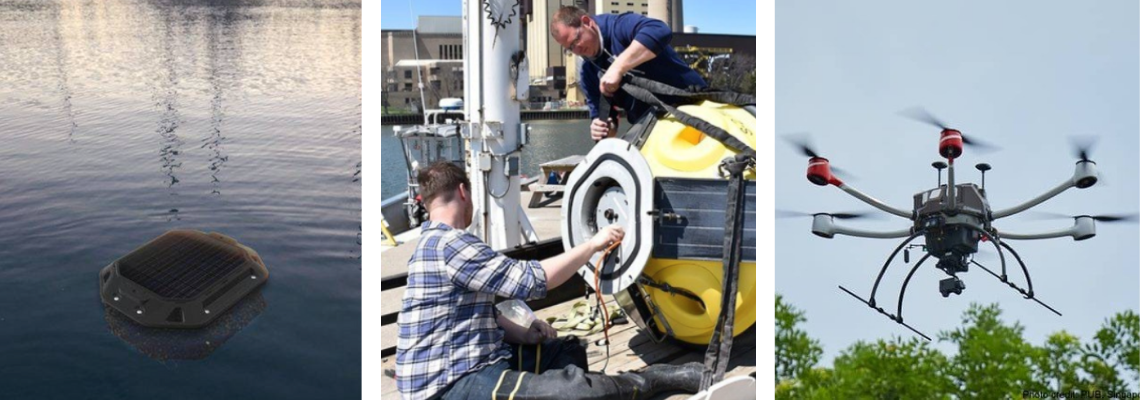5 companies shaping real-time surface water monitoring
Surface water monitoring technology is becoming an increasingly competitive landscape, as both the public and private sector seek to get a better understanding of the environmental impact on water sources.
Decreasing sensor pricing, coupled with technology becoming more robust has sparked new generations of companies wishing to put real-time data into hands of operators.
Aquatech Online previously reported on a UK Water Industry Research (UKWIR) report on drinking water quality that recommended the need to “understand how processes at different locations across the water cycle impact others”.
With this in mind, we look at five companies shaping the future of real-time surface water monitoring.
Real-time reporting on algae
Source: AquaRealTime
Meet the algae tracker. The Colorado-based surface water monitor company provides automated early detection of water-born harmful algae blooms (HABs).
AquaRealTime buoy uses an IoT Sensor that provides real-time monitoring of water assets by tracking key parameters every thirty minutes, including: green algae, blue-green algae (cyanobacteria), turbidity, temperature, sunlight, wind and rain.
It then feeds the real-time data into a centralised computer dashboard that displays the early alerts at key action thresholds.
AquaRealTime is marketing itself as a low cost, large scale data collection network that can monitor waterways - with the set-up taking just one hour and allowing customers to pay for its service on a subscription basis.
“Water quality is frequently taken for granted.”
Chris Lee, founder, and CEO of AquaRealTime said: “We are getting a lot of attention in the North American market as our solution is faster to implement, cheaper to maintain and it provides for better real-time reporting."
- 5 start-ups making sewers smarter
- 6 companies harnessing satellite data to improve water
- Democratising data: 5 start-ups to watch in water quality monitoring
Recently, Bertzman Social Ventures, a team that focus on both social impact investing and consulting, reported it invested in AquaRealTime so it could bulk and manufacture its hardware.
Neil Berman, the founder of Bertzman Social Ventures, said: “Water quality is frequently taken for granted. Only when the system fails do we get angry. It’s companies like AquaRealTime that ensure safe access to this essential need.”
Utility collaboration on solar powered floating monitors

Source: Watr
UK-start up Watr recently made the headlines after raising more than £320,000 from over 350 investors through the crowdfunding platform, Seedrs - exceeding its target of £250,000.
Watr has continued to develop its floating solar-powered surface water monitor system that provides real-time water quality data.
Earlier this year, the start-up successful completed its collaboration with water utility, Anglian Water.
"Over the last 18 months Anglian Water has been a great support and collaborative at every step of the way.”
During a 12-month trial with the east England water utility through one of its innovation programmes, Watr deployed its floating solar-powered multi-parameter water quality monitors along a stretch of Anglian Water's upstream catchment of abstraction points.
This saw Watr progress from innovation to business as usual (BAU) status with the water utility.
Glyn Cotton, CEO and co-founder of Watr speaking on the BAU said: "Over the last 18 months Anglian Water has been a great support and collaborative at every step of the way. I’m extremely proud the business has reached the point of BAU approval with Anglian Water."
Real-time monitoring to detect algae blooms

Source: LG Sonic
Another company Aquatech Online has recently tracked is Dutch technology company LG Sonic and its Monitoring Buoy.
The organisation has continued to add to its portfolio to help detect algae blooms in water lakes and reservoirs.
Its Monitoring Buoy solution combines real-time water quality monitoring and cloud software to store and analyse water quality data.
"Monitoring is vital to determine which solution is needed, not all lakes with algae problems are facing these challenges because of the same reasons.”
Lisa Brand, chief technology officer (CTO) of LG Sonic previously told Aquatech Online: “Algae blooms are increasing globally so fast now, it’s almost everywhere on the agenda. It’s not a local problem.”
The monitoring buoy continuously monitors water quality in real-time and delivers the data via radio, GPRS, or 3G to web-based software.
The system collects the following parameters: Chlorophyll α (green algae), Phycocyanin (blue-green algae), pH, Turbidity, Dissolved Oxygen, and temperature, with a possibility to include additional sensors.
Artificial intelligence (AI) is then used to predict algal blooms based on water quality data automatically.
"Monitoring is vital to determine which solution is needed,” added Brand. “Not all lakes with algae problems are facing these challenges because of the same reasons.”
A new tool in monitoring The Great Lakes

Source: RAEON
The Real-Time Aquatic Ecosystem Observation Network (RAEON)https://www.aquatechtrade.com/news/surface-water/detroit-deploy-new-algae-monitoring-buoy/ has recently worked with The Great Lakes Water Authority (GLWA), in partnership with LimnoTech and the University of Windsor, to place its buoy in the Detroit River.
The RAEON buoy is equipped with a camera that provides 20-second video clips every 10 minutes and can serve as an early warning for changing water quality.
“The buoys give us a new tool in monitoring, and reporting to the public, the conditions on the Great Lakes.”
Currently, one buoy has been deployed on the southwest intake of the Detroit River and monitors oxygen reduction potential, conductivity, temperature, pH levels, total algae and more.
The buoy’s sensor can monitor both the physical parameters such as wind speed, water temperature, and chemical and biological parameters.
“The buoys give us a new tool in monitoring, and reporting to the public, the conditions on the Great Lakes,” said Andrew Barnard, director of Michigan Technological University’s Great Lakes Research Centre.
"Their small size, relatively low cost and ease of deployment make them attractive solutions for difficult locations, like at Stannard Rock or at Isle Royale."
Going sky-high in Singapore

Source: PUB
Taking a very different approach to a floating buoy to provide real-time water monitoring, Singapore water agency PUB is looking to the sky to better track its water.
PUB is using Beyond Visual Line of Sight (BVLOS) drones equipped with remote sensing systems and a camera for “near real-time video analytics”.
The water agency has said it could save up to 5000 hours by deploying drones to monitor six of its water reservoirs.
ST Engineering was awarded the contract from PUB to use its drone operating system, DroNet, following trials last year. The drones will be housed in automated pods and capable of taking off and landing autonomously.
PUB estimates that it spends a total of 7200 hours on daily patrols to look out for excessive aquatic plants and algal blooms, as well as collecting data on the water activities to ensure they are conducted safely.
Drones, or Unmanned Aerial Vehicles (UAVs), are increasingly being used to help speed up monitoring processes in the water sector.
Related content
- Crowdfunding water technology – is it viable?
- Algae-monitoring drones to save 5000 hours in Singapore
- Oh Buoy: new monitoring system helps great lakes get ahead of algal blooms
Loading component...
We promise never to send you spam and you can unsubscribe at any time!

.jpg?h=628&iar=0&w=1200)

.jpg?h=628&iar=0&w=1200)